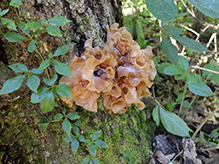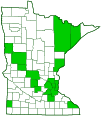Leafy Brain
(Phaeotremella foliacea)
Conservation • Description • Habitat • Ecology • Distribution • Taxonomy
Conservation Status |
|
|||||||
| IUCN Red List | not listed |
|||||||
| NatureServe | NNR - Unranked |
|||||||
| Minnesota | not listed |
|||||||
Description |
||
Leafy Brain is a common and widespread fungus. It occurs in Europe, Australia, Japan, Central America, and North America. In the United States it is most common east of the Great Plains and west of the Rocky Mountains. It is less common in Minnesota where it is at the western extent of its eastern range. It is found alone or scattered in coniferous and mixed forests and woodlands. It grows on on stumps, logs, fallen branches, and dead but still attached branches of conifers. It is parasitic on bracket fungi in the genus Stereum, including False Turkey Tail, Hairy Curtain Crust, and Crowded Parchment. It grows on the hidden basal threads (hyphae) of the fungus. The fruiting body is a 1½″ to 8″ (4 to 20 cm) long, ¾″ to 2¾″ (2 to 7 cm) high, loosely packed mass of wavy or leaf-like lobes. It appears seaweed-like, never cup-like or ear-like. Individual lobes are ¾″ to 2″ (2 to 5 cm) wide, and 1⁄32″ to 1⁄16″ (1 to 2 mm) thick. They are usually light to dark brown, sometimes purplish-brown or reddish-brown. They are gelatinous and pliable when fresh, hard when dry. The surface is hairless and smooth, becoming wrinkled toward the base. There is no stalk. The spore print is white. The flesh is edible but watery and tasteless. |
||
Similar Species |
||
Habitat and Hosts |
||
Coniferous and mixed forests and woodlands Stereum fungi |
||
Ecology |
||
Season |
||
Fall |
||
Distribution |
||||
|
Sources |
|||
| 6/2/2022 | ||||
Occurrence |
||||
Common and widespread |
||||
Taxonomy |
|||
| Kingdom | Fungi (fungi) | ||
| Subkingdom | Dikarya | ||
| Phylum | Basidiomycota (club fungi) | ||
| Subphylum | Agaricomycotina (jelly fungi, yeasts, and mushrooms) | ||
| Class | Tremellomycetes | ||
Order |
Tremellales | ||
Family |
Phaeotremellaceae | ||
Genus |
Phaeotremella | ||
This species was originally known as Tremella foliacea. DNA research published in 2015 showed that it was not closely related to othwer Tremella and it was placed in the genus Phaeotremella. Further analysis showed that it was actually a complex of several closely related but genetically distinct species. The name Phaeotremella foliacea now refers just to the species that grows on conifers. Two species growing on hardwoods are now called Jelly Leaf (Phaeotremella frondosa) and Brown Witch’s Butter (Phaeotremella fimbriata). |
|||
Synonyms |
|||
Tremella foliacea |
|||
Common Names |
|||
Leafy Brain |
|||
Glossary
Hypha
A thread-like cell of a fungus that is the main mode of vegetative growth: the basic structural unit of a multicellular fungus. Plural: hyphae. Collectively, the hyphae of a fungus is the mycelium.
Parasitic
Obtaining nutrients from another living organism.
Visitor Photos |
|||||
Share your photo of this fungus. |
|||||
| This button not working for you? Simply email us at info@MinnesotaSeasons.com. Attach one or more photos and, if you like, a caption. |
|||||
Kirk Nelson |
|||||
 |
|||||
MinnesotaSeasons.com Photos |
|||||
|
|||||

Slideshows |
||

Visitor Videos |
|||
Share your video of this fungus. |
|||
| This button not working for you? Simply email us at info@MinnesotaSeasons.com. Attach a video, a YouTube link, or a cloud storage link. |
|||
Other Videos |
|||
| Leafy Brain Fungus - Tremella foliacea Botany - Green Tamil |
|||
About
Dec 11, 2021 Tremella foliacea - Leafy brain Fungus, producing brownish, frondose, gelatinous basidiocarps. They are grow on dead attached and recently fallen branches of broadleaf trees and conifers. Commonly known as leafy brain, jelly leaf, and brown witch's butter. The species is said to be edible. The epithet "foliacea" means "leafy", with reference to the shape of the fruit bodies. |
|||
| Leafy Brain Jelly Fungus Lori Jackson |
|||
About
Nov 23, 2020 surprise on end of branch🤓 |
|||

Created: 9/19/2020
Last Updated:


